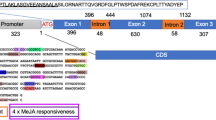Abstract
The large and diverseCercospora genus of plant pathogenic fungi includes many species that are causal agents of economically relevant leaf, stem, and seed blights of numerous crop plants. Several of these pathogens produce the red, photoactivated, phytotoxic polyketide toxin cercosporin. This mycotoxin is a crucial pathogenicity factor in the development of leaf and pod blights by the seed-borne soybean fungal pathogenCercospora kikuchii. Although certain cultivars may be less susceptible to the leaf- and pod-infection phases of the fungus, there are no soybean cultivars with resistance to cercosporin. A newly isolated gene fromC. kikuchil, known as LE6, is essential for cercosporin production and pathogenicity. Therefore, genetic manipulation of this gene may affect resistance to cercosporin. Transcription of LE6 is regulated by light. The expression of cercosporin also may be inhibited by certain growth media and other natural products. Modification of cultivar screens that target LE6 may greatly enhance the possibility of finding native resistance to this soybean pathogen. Soybean germplasm that produces strong LE6 downregulating or inhibiting compounds may enhance pathogen resistance. Thus knowledge of the genetic and physiological regulation of cercosporin should provide new technological strategies for biocontrol of mycotoxins and the development of soybean breeding lines that exhibit durable resistance toC. kikuchii.
Similar content being viewed by others
References
Daub, M.E., and M. Ehrenshaft,Physiol. Plant. 89:227 (1993).
Jenns, A.E., M.E. Daub, and R.G. Upchurch,Phytopathology 79:213 (1989).
Okubo, A., S. Yamazaki, and K. Fuwa,Agr. Biol. Chem. 39:1173 (1975).
Ehrenshaft, M., and R.G. Upchurch,Appl. Environ. Microbiol. 57:2671 (1991).
Callahan, T.M., M. Ehrenshaft, and R.G. Upchurch,Phytopathology 83:1422 (1993).
Upchurch, R.G., D.C. Walker, J.A. Rollins, M. Ehrenshaft, and M.E. Daub,Appl. Environ. Microbiol. 57:2940 (1991).
Upchurch, R.G., M. Ehrenshaft, D.C. Walker, and L.A. Sanders, Ibid.:2935 (1991).
Callahan, T.M., and R.G. Upchurch, in section H-24,Abstr. Am. Soc. Microbiol., 1994, p. 204.
Meade, M.J., and R.G. Upchurch, in section O-24,Ibid., 1994, p. 358.
Orth, C.E.,Plant Dis. 78:661 (1994).
Pathan, M.A., J.B. Sinclair, and R.D. McClary, Ibid.:720 (1989).
Rollins, J.A., M. Ehrenshaft, and R.G. Upchurch,Can. J. Microbiol. 39:118 (1993).
Ehrenshaft, M., and R.G. Upchurch,Physiol. Mol. Plant Pathol. 43:95 (1993).
Author information
Authors and Affiliations
About this article
Cite this article
Upchurch, R.G. Genetic regulation of cercosporin production inCercospora kikuchii . J Am Oil Chem Soc 72, 1435–1438 (1995). https://doi.org/10.1007/BF02577834
Received:
Accepted:
Issue Date:
DOI: https://doi.org/10.1007/BF02577834




